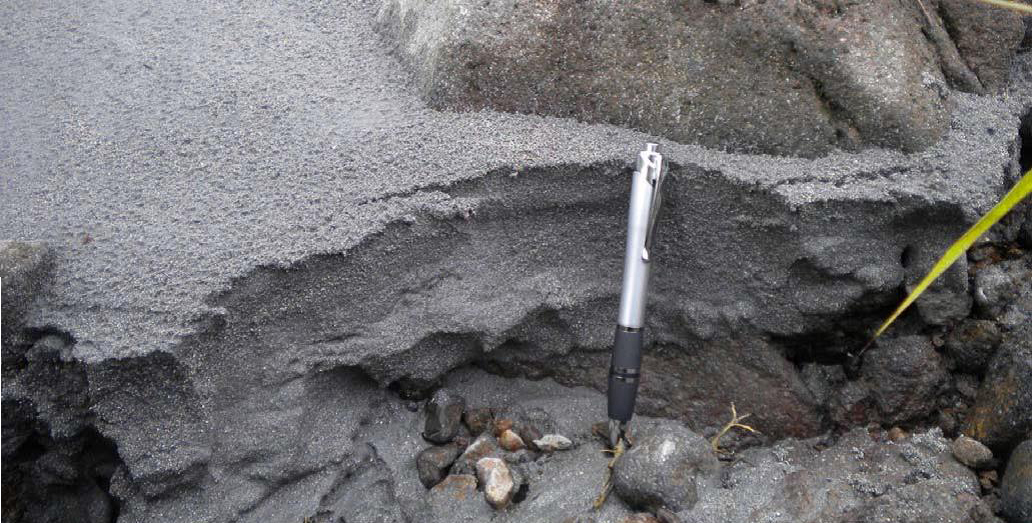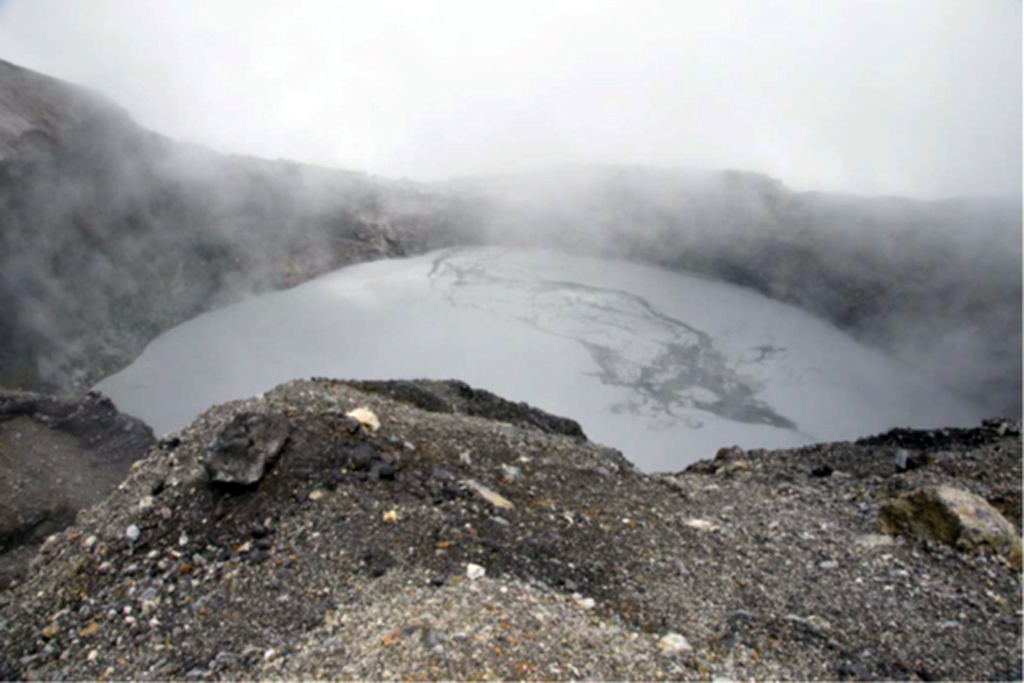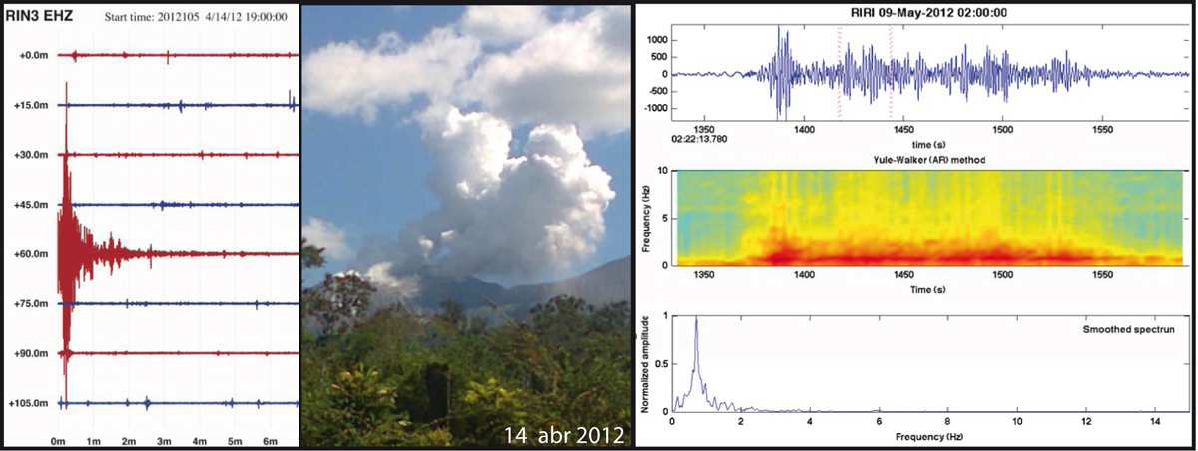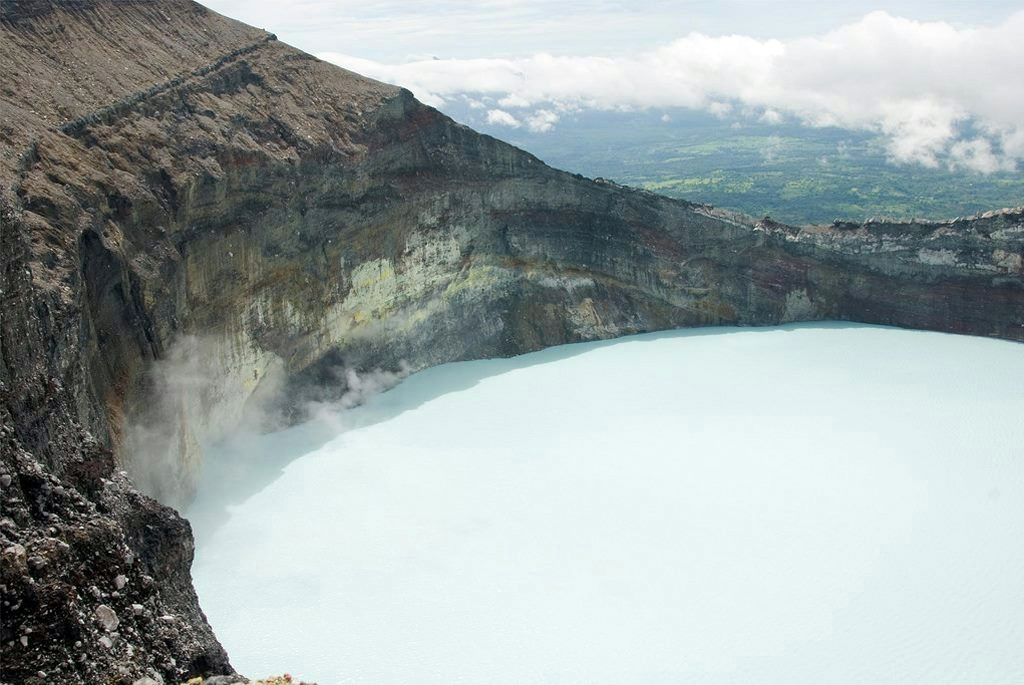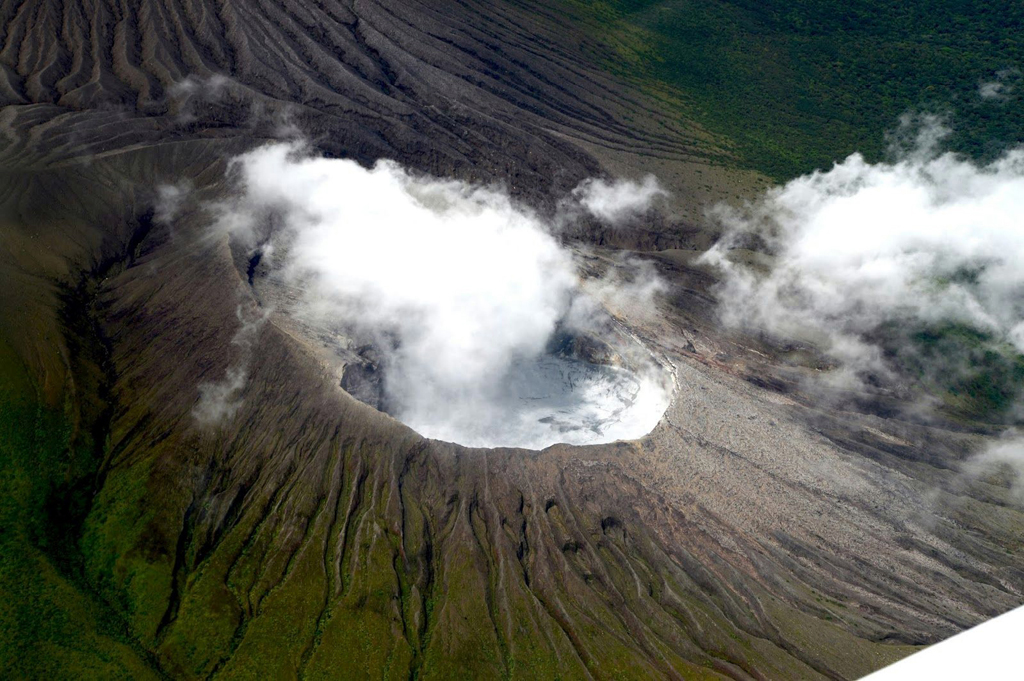Report on Rincon de la Vieja (Costa Rica) — January 2016
Bulletin of the Global Volcanism Network, vol. 41, no. 1 (January 2016)
Managing Editor: Edward Venzke.
Edited by A. Elizabeth Crafford.
Rincon de la Vieja (Costa Rica) Explosive eruptions resume in August 2011 after 13 years; intermittent activity through 2015
Please cite this report as:
Global Volcanism Program, 2016. Report on Rincon de la Vieja (Costa Rica) (Crafford, A.E., and Venzke, E., eds.). Bulletin of the Global Volcanism Network, 41:1. Smithsonian Institution. https://doi.org/10.5479/si.GVP.BGVN201601-345020
Rincon de la Vieja
Costa Rica
10.83°N, 85.324°W; summit elev. 1916 m
All times are local (unless otherwise noted)
Costa Rica's Rincon de la Vieja volcano, part of a large volcanic complex in the Guanacaste Range, has had intermittent phreatic explosions with historical observations dating back to 1765, often separated by decades of inactivity. Major eruptions in the mid-1990s caused large mudflows and significant damage to the local communities. Since that time the volcano has presented persistent subaerial and subaqueous fumarolic activity around the crater lake, but otherwise has been quiet. Costa Rica's Observatorio Vulcanologico Sismologica de Costa Rica-Universidad Nacional (OVSICORI-UNA) monitors the volcano, and after the 2011 eruptive episode (discussed below) installed new monitoring equipment, in conjunction with Observatorio Sismológico y Vulcanológico Arenal-Miravalles del Instituto Costarricense de Electricidad (OSIVAM-ICE), which also tracks events at the volcano.
The first explosions since 1998 began on 22 August 2011. This was followed by several more phreatic eruptions in September 2011. Explosions were again reported in February, April, and October 2012. No explosions were reported in 2013, although unusual seismic activity was recorded. In 2014, explosions were reported in September and October. Increased seismic activity and phreatic eruptions again occurred in June, August, and October 2015. There were no VAAC reports or MODIS thermal anomalies reported between January 2011 and December 2015.
Activity during 2011. Activity in early 2011 consisted of mild underwater and surface fumarolic activity in the SW and S wall of the active crater, and a moderate level of emissions. The acidic lake had a light gray color with sulfur particles in suspension. This was characteristic of conditions at the volcano over the previous 13 years.
Conditions changed on 22 August 2011, when a local guide reported seeing a column of dark material erupt 5 m high above the lake. Another eruption was observed on 9 September by a local guide; the fine sediment from that explosion was deposited on the N rim of the crater. On 16 September an eruption was heard by local guides around 1400, and an ash plume rose above the crater and deposited material 200 m downhill from the N edge of the crater. Heavy rain later in the day eroded most of the new material into the nearby Zanjon and Azufrada streams. The volcanic material caused changes in water quality along the main creeks and major rivers north of the volcano. Dead fish were noted the next day in the town of Buenos Aires de Upala (7.5 km N) and Birmania de Upala (18 km NNE). On the morning of 23 September, residents of Dos Rios de Upala (10 km NW) observed light gray ash on the northern edge of the crater from an eruption during the previous night.
OVSICORI-UNA scientists visited during 27-29 September 2011 to confirm the eruption and document its effects. Streams flowing north from the crater contained deposits up to 15 cm thick of fresh volcaniclastic sediment from the eruptions (figure 16) at least 2 km away. A thin layer of ash was also observed on nearby vegetation.
The scientists observed that the lake was actively convecting, and grayish in color due to the suspended sediments (figure 17). They also observed a small eruption from a cell at the center of the lake that rose about 1 m. The fumarolic activity was concentrated in the S and SW parts of the inner crater wall, and plumes of steam and gas rose above the eastern edge of the crater.
Several hot springs are located on the N flank. Readings from a thermometer installed near the hot springs indicated a systematic and substantial increase in water temperature between August and September 2011, consistent with the reports of renewed eruptive activity. The lake is highly acidic (pH
No eruptions were reported in October 2011, but when scientists visited again on 23 November the lake level remained high, was light gray in color, and had a temperature of 34°C. Poor weather prevented visual observation, but rumbling noises from the lake suggested a small phreatic event at 1050 local time which was recorded by the nearby seismic station.
Activity during 2012. Intermittent phreatic explosions continued in 2012. OVSICORI-UNA reported that seismic data revealed two eruptions on 19 and 20 February. The Red Sismologica Nacional (RSN) also reported two more small eruptions on 23 February when explosions were heard in Guachipelin (11 km SW) between 0400 and 0430, although these events were not recorded seismically. A somewhat larger eruption occurred at 1400 on 14 April 2012, which was clearly recorded by the nearby seismic equipment, visually observed, and also heard as an explosion that generated a column of vapor and sediments visible from Buenos Aires and Aguas Claras de Upala, ~7 km N of the crater (figure 18). A seismic event on 9 May that was not associated with any unusual surface activity was thought by OVSICORI-UNA scientists to be possibly associated with fluid movement inside the volcano (figure 18).
In October 2012, seismicity was dominated by tremors of very low amplitude and low frequency. One small phreatic eruption was recorded on 17 October 2012.
There were no significant changes in the physical or chemical parameters of the lake in 2012. In March, the temperature was 29°C and the pH was 0.42, and in December the temperature was 33°C and the pH was 0.37. Molten sulfur was observed floating on the surface during both visits. The temperatures of the fumaroles on the N flank of the volcano remained around 90-91°C, and the fumaroles SW of the crater were measured at 96-100°C during 2012.
Activity during 2013. OVSICORI-UNA received reports at 0530 on 26 February 2013 from police in Buenos Aires de Upala of pulsing white plumes rising from the active crater about every four minutes. The seismic records showed no signals associated with a phreatic eruption or sudden gas output, and no other reports from local communities were received. Cloud cover prevented thermal imaging during an overflight the next day; however, clear views of the N and S flanks and areas SW showed no evidence of ashfall, and thus OVSICORI-UNA scientists concluded that no eruptive activity had occurred. A plume from the crater was visible on a still day on 20 March from Buenos Aires de Upala (7.5 km N). In April fumarole temperatures were measured at over 130°C, and highly active convection cells with regular pulses of heat about every three minutes were observed in the lake. The lake pH was 0.1, and temperature measured with the thermal camera was 36°C.
In May 2013, Observatorio Sismológico y Vulcanológico Arenal-Miravalles del Instituto Costarricense de Electricidad (OSIVAM-ICE) reported an increase in seismic activity, characterized by an increase in the amplitude of low-frequency hybrid and VLF signals (
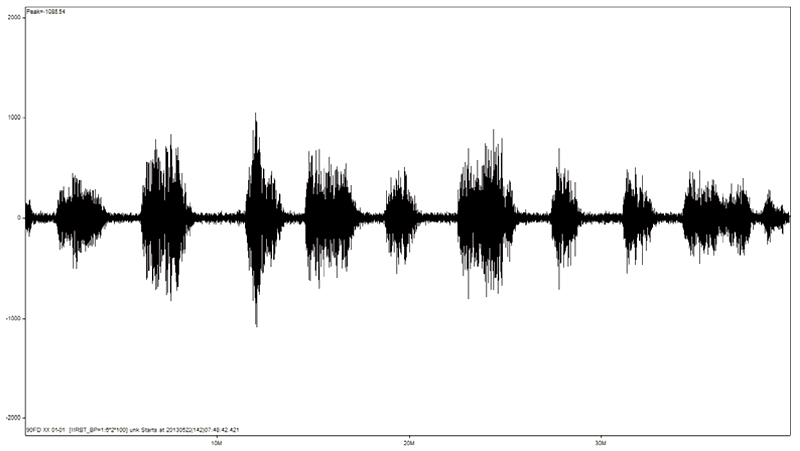 |
Figure 19. Hybrid-type seismic events recorded on 22 May 2013 at Rincon de la Vieja. Courtesy of OVSICORI-UNA (Monthly Bulletin, May 2013). |
Activity during 2014. In April 2014, for the first time, scientists were able to record measurements of SO2 emissions at Rincon de la Vieja. Values of around 70 metric tons per day were measured using a FlySpec V3 system. Seismicity remained low until September when several tremor episodes and low-frequency earthquakes occurred. OVSICORI-UNA reported that at 1237 on 17 September 2014 a seismic signal indicating a phreatic explosion was detected by a station about 5 km S of the volcano. A second explosion, detected at 2048 and lasting three minutes, was of a larger magnitude and a longer duration. Additional explosions were also detected at 1825 on 19 September and at 0304, 0439, and 0634 on 20 September. Residents on the N flank who heard the event on 19 September and saw the explosion at 0634 on 20 September reported that ejecta did not reach beyond the crater. An overflight on 20 September revealed that the temperature of the lake water was about 45°C, an increase from about 30°C measured in April. In addition, significant increases in acidity, electrical conductivity, and sulfate/fluoride and sulfate/chloride ratios were observed in September. Extensive low-frequency earthquakes and tremors (lasting for six hours) were again reported on 27 September.
On 24 October a small phreatic eruption was recorded, but otherwise seismic activity remained low. Gas measurements in early October indicated a significant decline in the CO2/SO2 and H2S/SO2 ratios of gases as compared with measurements made prior to the eruptions of September 2014. On 9 November a neighborhood north of the volcano observed a diffuse plume of steam coming from the crater, but there was no associated seismic signal, and thus OVSICORI-UNA scientists concluded that it was not a phreatic explosion. By November the fumaroles on the inner W wall of the crater were much quieter, and the lake was a milky turquoise color at a very high level due to significant precipitation (figure 20).
Activity during 2015. In May and June 2015 OVSICORI-UNA and OSIVAM-ICE installed new dataloggers and temperature sensors at two hot springs located approximately 3.2 km NE (the "Land of Senses Sanctuary") and 7.5 km N (the Blue River Sanctuary) of the active crater with the intent of monitoring changes in the water temperature and chemistry at the hot springs. At 2001 on 16 June and 1729 on 18 June, phreatic explosions that were preceded by LP and "tornillo" type seismic signals were recorded, but otherwise seismic activity was low during the month. Another small phreatic eruption that was barely distinguishable from ambient noise was recorded by OSIVAM-ICE and OVSICORI-UNA seismographs on 21 August at 0313 local time and lasted for about 80 seconds.
Activity increased substantially in October 2015, when at least ten small to moderate phreatic eruptions were recorded. On 1 October a long-period (LP) signal was recorded with a duration of 180 seconds possibly associated with a moderate exhalation of gas or vapor and a small phreatic eruption in the active crater. During a visit on 8 October, scientists observed fresh sediments and altered rock fragments around the eastern edge of the crater likely from a moderate eruption that occurred at 0624 on 4 October. Vigorous convection cells were also observed in the milky-gray lake. The most significant seismic activity occurred on 16 October and lasted for seven hours and was probably accompanied by a moderate phreatic eruption. In an aerial view on 17 October freshly ejected material was observed on the N flank (figure 21). The biggest eruption was recorded on 21 October. The largest eruptions ejected materials from the lake bottom towards the north side of the crater. Heavy rains washed these materials down river drainages. Seismicity remained low in November 2015, and no further phreatic eruptions were reported in 2015.
Geological Summary. Rincón de la Vieja, the largest volcano in NW Costa Rica, is a remote volcanic complex in the Guanacaste Range. The volcano consists of an elongated, arcuate NW-SE-trending ridge constructed within the 15-km-wide early Pleistocene Guachipelín caldera, whose rim is exposed on the south side. Sometimes known as the "Colossus of Guanacaste," it has an estimated volume of 130 km3 and contains at least nine major eruptive centers. Activity has migrated to the SE, where the youngest-looking craters are located. The twin cone of Santa María volcano, the highest peak of the complex, is located at the eastern end of a smaller, 5-km-wide caldera and has a 500-m-wide crater. A Plinian eruption producing the 0.25 km3 Río Blanca tephra about 3,500 years ago was the last major magmatic eruption. All subsequent eruptions, including numerous historical eruptions possibly dating back to the 16th century, have been from the prominent active crater containing a 500-m-wide acid lake located ENE of Von Seebach crater.
Information Contacts: Observatorio Vulcanologico Sismologica de Costa Rica-Universidad Nacional (OVSICORI-UNA), Apartado 86-3000, Heredia, Costa Rica (URL: http://www.ovsicori.una.ac.cr/); Observatorio Sismológico y Vulcanológico Arenal-Miravalles del Instituto Costarricense de Electricidad (OSIVAM-ICE), Sección de Sismología, Vulcanología y Exploración Geofísica, Escuela Centroamericana de Geología Apdo. 214-2060, San Pedro, Costa Rica (URL: http://rsn.ucr.ac.cr/actividad-volcanica/reportes-volcanicos); Red Sismologica Nacional (RSN), Sección de Sismología, Vulcanología y Exploración Geofísica, Escuela Centroamericana de Geología, Apdo. 214-2060, San Pedro, Costa Rica (URL: http://rsn.ucr.ac.cr/); Insidecostarica.com (URL: http://www.insidecostarica.com/dailynews/2012/february/24/costarica12022404.htm).


